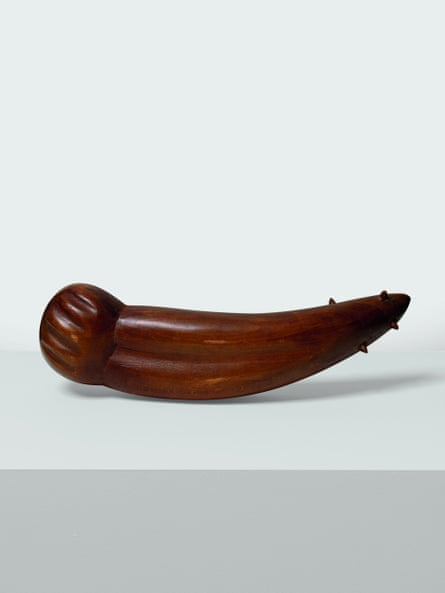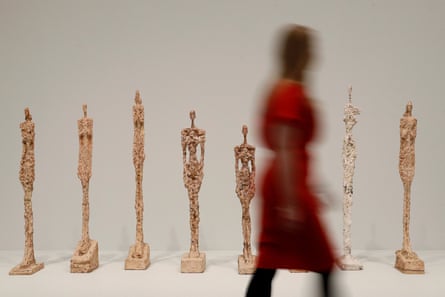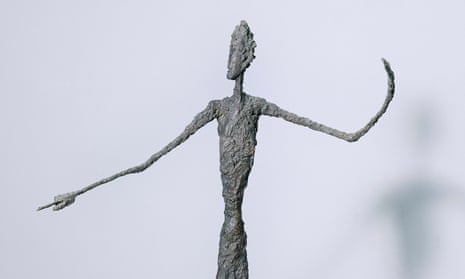Midway through this exhibition, emotion hits you like a blast of heat from a furnace. The chill of irony thaws. The intellectual and erotic games are over. There is only one thing worth making art about, Alberto Giacometti has decided, and that is our common humanity.
What a slender thread humanity must have seemed in Europe in the 1940s. The thin figures that emerged like wisps of smoke out of Giacometti’s conscience in the second part of that murderous decade seem barely to exist. They are not so much statues as mirages of people glimpsed far away, shimmering on a horizon of ash. The human form, starved, bereft, but somehow standing tall.
Tate Modern has created a truly great exhibition of an artist whose compassion and honesty matter more now than ever. Giacometti was one of the most sensually gifted sculptors of the modern age, up there with Rodin, Brancusi and Picasso as a manipulator of form. Yet in the final quarter-century of his life he set aside his ingenuity to concentrate on something more urgent: the truth. As Paul Gauguin once asked in the title of a painting, Where do we come from? What are we? Where are we going? Gauguin pondered these questions in the age of Oscar Wilde; Giacometti asked them in the shadow of the Holocaust.

It is the achievement of this exquisitely well-selected and consummately beautiful exhibition to make you see Giacometti’s art for the first time, appreciate its tactile genius and then, with fresh horror and sadness, understand the depths of tragedy out of which he speaks.
Giacometti, who was born in the Italian-speaking Swiss Alps in 1901 and was inspired to become an artist partly by looking at Renaissance masterpieces, was always an unlikely modernist. A wonderful display at the start of this exhibition shows his progression from carving realistic human heads at the beginning of his career to making profoundly true portraits at its end. Yet in between he was one the most dangerous and uncompromising artists of the surrealist movement. The surrealists thought Freud’s theory of the unconscious was a key to creativity and human liberation. It certainly released something in Giacometti. Yet his menacing pointy biomorphs and eerie dream machines reveal a bleak interior universe of unpitying sex and violence.
In the 1930s, his art had shared enthusiastically in a collective sickness. Europe in the age of Hitler was headed for hell, abandoning civilised norms, mocking dull decencies. Violence throbbed like an electric pulse through fascist politics and avant-garde art alike. There is arguably no more perfect artistic symptom of the 30s than Giacometti’s Woman With Her Throat Cut (1932). This twisted splayed bronze is sprawled across a white plinth at Tate Modern, a vicious cut all but severing its long thin neck. Its body, inspired by the insect anatomy of a praying mantis, is all spikes and concavities. Such crudely effective markers of male and female abound in Giacometti’s surrealist phase. Disagreeable Object (1931) is a massive dildo with spikes, Spoon Woman (1927) a body as a giant curvy space.
Looking Freud-like at his dreams must have terrified Giacometti, for by the end of the 30s he abandoned surrealism as if it were an addiction he needed to kick. His surrealist sculptures are absolutely brilliant, yet utterly unlovable. They clearly did not satisfy him. “The sleep of reason produces monsters,” warned Goya. Giacometti must have become sick of giving birth to monsters. Europe was making enough real ones by 1939 – who needed artistic nightmares when history was turning into a macabre death dance?

Suddenly only people matter. He is driven to hold on to love and friendship, to see a few familiar faces over and over again in playful but tender remakings of the human image. Silvio Standing With His Hands in His Pockets (1943) is like a little cartoon hero, moulded in plaster, perkily surviving in a blitzkrieged world. From quirky caricatures he finds an art worthy of the weight of its time. By 1947 he is casting Man Pointing, a bony monument, gesturing towards the reality we must see.
Millions were dead and art scarcely seemed justified or tolerable. Magritte, Ernst and Dalí all seemed artists of an earlier age; European art itself appeared to have faded in the continent’s ruins. Only Giacometti rose to the moment with stark, severe sculptures of people who seem to have lost everything – and yet who keep walking, pointing, speaking.
The 20th century’s anguish looks both ancient and universal through Giacometti’s understanding eyes. Right through this exhibition, from such early works as Crouching Figure (circa 1926) with its squat echo of Aztec art, to the very last monumental stick-people with their reminiscence of Etruscan sculpture, Giacometti’s passion for ancient and “primitive” art is constantly enriching and emboldening his vision. Many modern artists were fascinated by “primitive” sculpture – that intrigue is close to being the very definition of modernist art – but Giacometti stands alone in the moral depth of his engagement. His drawings of ancient Egyptian art are juxtaposed with some of his tall heroic bronzes. He gives the modern condition the grandeur of myth.
Do we deserve that compassion? Looking at Giacometti’s people melting in empty space, at the gaps and holes in them, you can’t help asking: are we still human? We probably are, so long as we keep looking at this incomparable visionary.

Comments (…)
Sign in or create your Guardian account to join the discussion